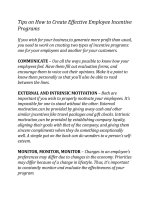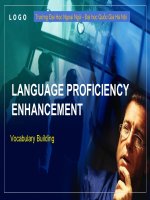How to build up your Vocabulary
Bạn đang xem bản rút gọn của tài liệu. Xem và tải ngay bản đầy đủ của tài liệu tại đây (1.81 MB, 53 trang )
L O G O
LANGUAGE PROFICIENCY
ENHANCEMENT
Vocabulary Building
Trường Đại Học Ngoại Ngữ - Đại học Quốc Gia Hà Nội
Overview
1. New Conceptions about Teaching and
Learning Vocabulary
2. Techniques for Building up Your
Vocabulary
3. Vocabulary Learning Resources
1. New conceptions about
teaching and learning vocabulary
Do you agree, disagree or keep a neutral
view on these statements?
ANSWER
Actually, they are all MYTHS about
vocabulary learning and teaching!
Myth1: It is not good to use lists of
words when learning vocabulary
Four models of presentation:
1) words presented in isolation
2) words in minimal context
3) words in text context
4) words in elaborated text context.
Myth 2: Vocabulary should be
presented in semantic sets
Learners had more difficulty learning new
words in semantic clusters (Tinkham 1993).
Myth 3: The use of translations is a
poor way to learn new vocabulary
The value of translations in vocabulary-
learning activities (Hulstijin 1992; Knight
1994; Prince 1995; Chun & Plass 1996;
Laufer &Shmueli 1997; Grace 1998; Laufer
& Hulstijin 1998).
•
Myth 4: Guessing words from context is as
productive for foreign language learners as it is
for first language learners
Helpful contexts are rare (Schatz &
Baldwin 1986).
Myth 5: The best vocabulary learners make use of
only one or two effective specific vocabulary
learning strategies
Learners’ proficiency level and type of
instruction did not impact their vocabulary
learning (Sanaoui 1995).
•
Myth 6: Foreign language learners
should use a monolingual dictionary
The use of a bilingual dictionary can
increase vocabulary learning (Luppescu &
Day 1993).
Myth 7: Vocabulary is sufficiently covered enough
in our curricula and courses
No overall plan of vocabulary instruction in
the curriculum (Folse 2004).
Overview
1. New Conceptions about Teaching and
Learning Vocabulary
2. Techniques for Building up Your
Vocabulary
3. Vocabulary Learning Resources
2. Techniques for Building up Your
Vocabulary
INPUT - OUTPUT
INPUT - Techniques for Building
up your Vocabulary
1. 3000 Basic Words
2. Word Structure: Prefix –
Suffix – Base
3. Thesaurus
Synonyms, Antonyms
Related Words (of the
same Semantic Field)
4. Context
5. Pictures
6. Word Webs, Diagrams
7. Flashcards
8. Confusable Words
9. Games
10. Reading
11. A word a day
(1). 3000 Basic Words
Source: Oxford Advanced Dictionary
(2) Word Structure:
Prefix – Suffix – Base
Source: Chin, B.A. (2004). How to build a
super vocabulary. John Wiley & Sons, Inc.
(3) Thesaurus
Synonyms and Antonyms
Related words
(4). Context
General context
In her essay about Robert Frost’s “Mending Wall,”
Nora says she believes that the poem’s last line is
deliberately ambiguous. “I think Frost meant us TO
INTERPRET THAT LINE IN MORE THAN ONE WAY.
There’s NO SINGLE CORRECT MEANING. In fact,
there may be SEVERAL MEANINGS. We’re meant TO
PUZZLE OVER WHAT THE LINE MEANS.”
Definitions in Context
Every Friday after school, Lara attends a
class in botany, the study of plants, at the
science museum.
Other Clues to Meaning
You can recognize conifers—such as pine, fir,
cedar, and spruce—by their seed-bearing
cones.
(5) Pictures
Ready-made pictures
E.g. secure
Hand-drawn pictures
E.g. bow
ENTERTAINMENT
MUSICTV
TYPES
INSTRUMENTS
pop
rock
ballad
guitar piano drums
comedy news
6. Word Webs and Diagrams
(7) Flashcards
Dolphin vs. whale?









